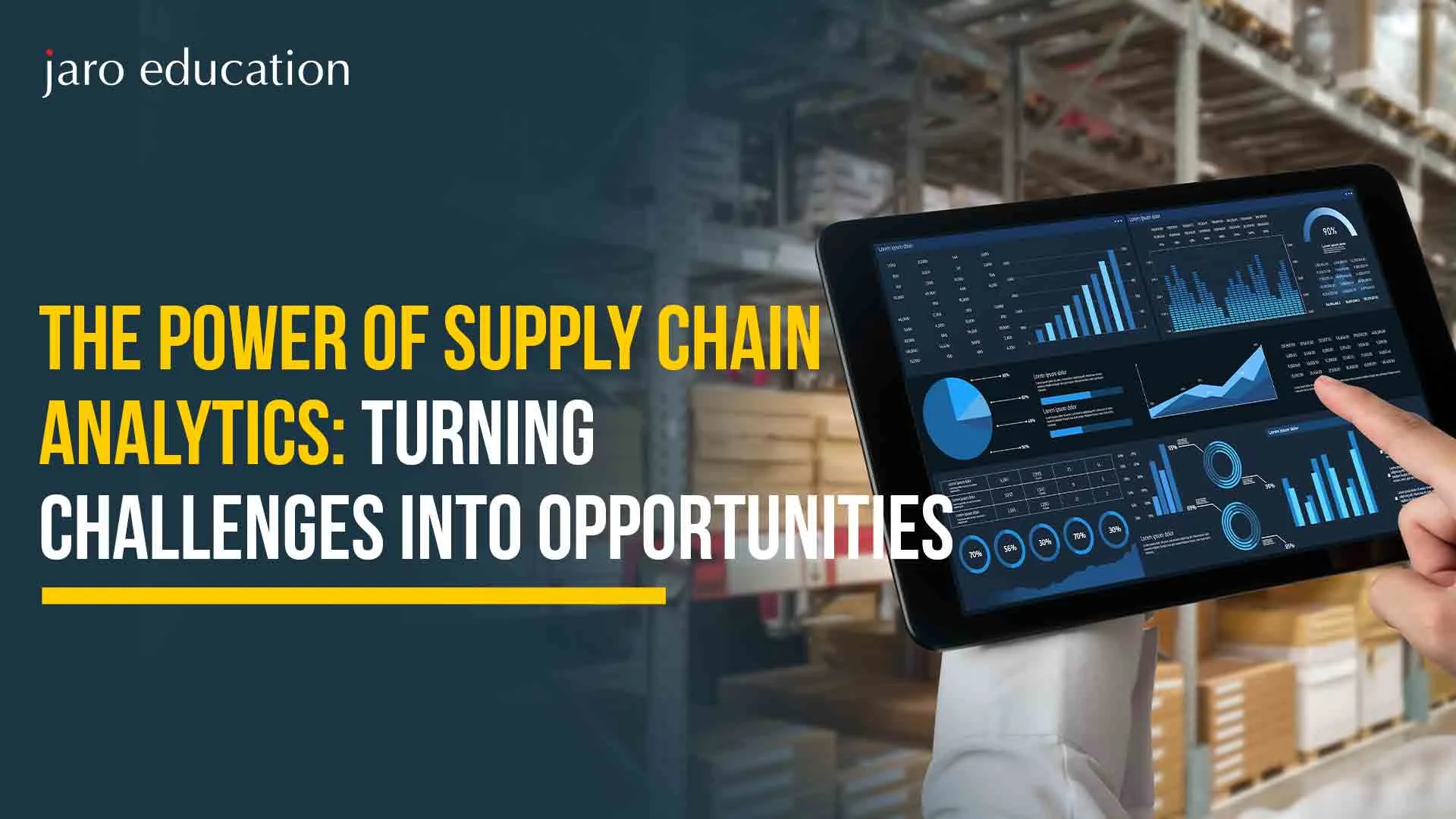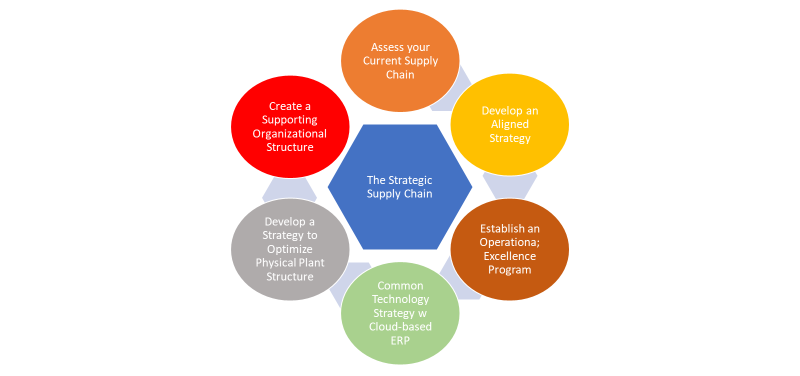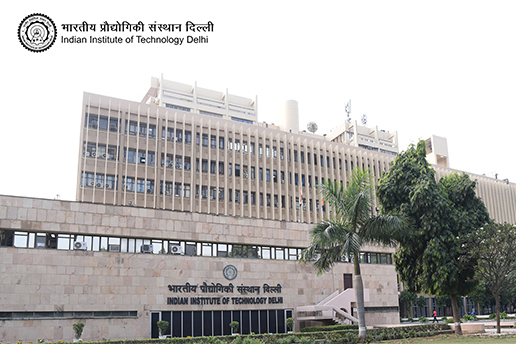The Power of Supply Chain Analytics: Turning Challenges into Opportunities
Table of Contents

In today’s business world, the supply chain is the backbone of a business because it helps keep the organisation running smoothly, especially in logistics. As markets change not only in India but worldwide, businesses are turning to supply chain analytics to enhance their operations. This is where supply chain analytics comes in – methods which provide various ways to utilise data for insight generation, process optimisation, and ultimately, an increase in profit.
However, there are some challenges that an organisation has to face when using analytics, such as economics and globalisation. Fortunately, by implementing effective strategies, these challenges can still transform into opportunities. In this blog, we will focus on outlining how to convert potential challenges into opportunities using analytics that every organisation can adopt in this environment. Let’s get started.
Understanding Supply Chain Analytics
Supply chain analytics is about using data analysis tools and approaches to analyse, interpret, and visualise data concerning supply chain activities and processes – allowing businesses to monitor performance metrics, predict demand, optimise inventory levels, and evaluate suppliers more accurately. Nowadays, where big data is common, the agility to interpret this information and respond to it is a key differentiator between companies that thrive and those that lag behind.
Key Components of Supply Chain Analytics
- Descriptive Analytics: This involves looking back at historical data to analyse past performance. Organisations can gain an understanding of trends and patterns which can serve as a basis for the future.
- Predictive Analytics: Organisations are able to use statistical modelling as well as machine-learning algorithms to predict future demand and identify supply chain disruptions. This foresight enables organisations to make better-informed decisions.
- Prescriptive Analytics: This analytics type focuses on taking action after insight is gained from analytics. Businesses are able to analyse multiple scenarios to identify which actions to implement within their supply chains.
- Real-Time Analytics: With all of the technology evolving and moving towards real-time use of data analytics, supply chains can be monitored in real-time. This creates a much better response time and agility, as organisations will have the ability to act quickly when problems arise in their supply chain.

*theknowledgeacademy.com
The Impact of Global Tariffs on Supply Chains
One of the major issues supply chains are facing today is the introduction of tariffs on a global scale. Tariffs, which can be considered taxes on imported goods, can create a trickle-down effect through supply chains and create multiple challenges. Understanding these impacts is critical for companies preparing to respond to this complex landscape.
Increased Import Costs
Tariffs increase the cost of imported goods to impact a company’s profitability. Businesses face the tough call of either taking these costs on the chin, which would reduce profit margins, or passing those costs on to the customer and potentially reducing demand. Thin margins no longer afford companies the luxury of simple pricing strategies—they need to implement sophisticated pricing strategies that will allow them the flexibility to adjust to growing costs while maintaining a certain competitive edge.
Changes in Demand
As tariffs raise prices, consumer behavior may shift. Customers may reconsider their purchasing decisions, leading to decreased demand for specific products. Understanding these changes is crucial for businesses to adjust their strategies accordingly. Companies must remain agile, ready to pivot their offerings based on evolving consumer preferences.
Supply Chain Disruptions
Changes in tariff policies can greatly disrupt established supply chains. Companies may have to move quickly to change their sourcing strategy, which can create changes in trade flows. Congestion at ports and in other areas of transportation can lead to delays, which raise the cost of goods and disrupt supply chains. Disruption affects pricing but can also result in shortages of needed products.
Uncertainty and Volatility
Frequent shifts in tariff policies introduce uncertainty, complicating long-term planning and demand forecasting. This unpredictability can make it challenging for businesses to manage inventory effectively. The risk of retaliatory measures from other countries further exacerbates this volatility, creating a complex environment for compliance and accurate reporting.
Disruption of Established Supplier Relationships
Complex supply chains on a global scale depend upon detailed networks of suppliers, and in some cases, companies are forced to abandon suppliers with years of experience working with the manufacturer due to tariffs. This also leads to substitutes that are simply not going to be as reliable as the lost source supplier. There are usually challenges to changing suppliers, including lengthened lead times, quality issues, and supply chain disruption, that could lead to delivery issues that ultimately affect the client.
Turning Challenges into Opportunities
Despite the challenges posed by global tariffs, businesses can view these obstacles as opportunities to reassess and optimise their supply chain strategies. Here are several approaches to consider:
1. Leveraging Analytics and AI
Utilising AI-powered analytics can help businesses forecast potential tariff impacts and optimise their sourcing strategies. This approach involves:
- Real-Time Visibility: Utilising advanced supply chain management systems provides real-time visibility into costs, compliance, and spending patterns. This visibility allows the business to make timely, informed decisions.
- Improved Planning: Companies can proactively adjust procurement strategies based on advanced analytical assessment of disruptions. Companies can better mitigate risk when they know where potential disruption may occur.
- Digital Twins: Digital twins simulating different configurations in a supply chain can allow the company to model changes in real-time before implementing them. Visualising several alternative scenarios can allow better decisions.
2. Supply Chain Optimization and Diversification
To mitigate the impact of tariffs, companies should focus on optimising their purchasing decisions and diversifying their supply chains. This can include:
- Smart Stock Management: Deciding whether to increase stock levels ahead of tariffs or to implement a Just-In-Time (JIT) buying strategy. Depending on inventory holding costs and the likely disruption created by tariffs, companies must find the right balance to operate efficiently.
- Alternative Sourcing: Identifying potentially nearby alternative suppliers can help reduce tariff exposure. Building new supplier relationships may have complexities and transition costs, yet alternative sourcing along with nearby suppliers may create a stronger supply chain.
- Reviewing Trade Agreements: Identifying favourable trade agreements to reduce costs and tariff exposure will lower tariffs’ impact. Companies need to keep abreast of changing trade policies and seize opportunities to reduce overall exposure to tariffs.
3. Modeling "What-If" Scenarios
Data analytics enables businesses to conduct scenario planning, significantly reducing uncertainty:
- Predictive Modelling: Utilising predictive analytics to forecast costs, risks, and demand shifts associated with tariff changes. This proactive approach helps companies prepare for various outcomes.
- Cloud-Based Analytics: Implementing cloud solutions to improve scenario planning allows businesses to respond rapidly to market fluctuations and trade policy changes. This agility is vital for maintaining a competitive advantage.
4. Unclogging Bottlenecks
Logistical blockers can limit supply chain efficiencies. Here are recommendations from professionals about how businesses can tackle challenges and remove blockers:
- Optimise Routes: AI-powered tools to optimise routes and monitor real-time locations will mean fewer delays and costs. Efficient logistics will positively affect supply chain performance.
- Automate Customs Tasks: Automation of customs and documentation tasks will help speed up clearance and reduce delays. It can also optimise and make logistics operations more efficient. Ultimately this means that delivery timelines are enhanced.
- Predictive Analytics: Predictive analytics will help avoid congestion and prepare alternate sourcing of raw materials. Predictive analytics should also predict failures; therefore, adjustments can be made before issues arise.
The Role of Technology Solution Providers
Navigating the complexities of tariffs and their impacts on supply chains can be daunting. Technology solution providers offer valuable expertise and tools to streamline operations, ensuring businesses can adapt effectively to challenges.
Unified Data Integration
Cutting-edge solutions can combine various data sources, such as import data, vendor bills and market data, together into one manageable system. This can provide quick access to tariff information that will help you make better decisions.
Real-Time Visibility
With sophisticated analytics and reporting tools, businesses can easily view tariffs and how they affect the business. When you have visibility and understanding, companies can take action to reduce risks and to improve their supply chain.
Scenario Analysis
Data integration facilitates detailed scenario analyses, allowing businesses to predict tariff impacts and make informed, strategic decisions for long-term planning.
Compliance and Regulation
Integrated systems make sure that businesses keep current records so that they can comply with customs and trade regulations and also avoid penalties. In order for businesses to maintain operational integrity, compliance is crucial.
Crafting a Strategic Plan
While numerous tactics and technologies can help businesses navigate the challenges posed by global tariffs, the foundation lies in having a solid strategic plan. Companies should assess their current readiness and identify areas for improvement.
Steps to Develop a Strategic Plan

*linkedin.com
- Analysis of Current Operation: Review the present supply chain processes to understand what is done correctly and areas where improvement is required. The first step to optimization is understanding where to have improvements made.
- Engagement with Stakeholders: Engage with key stakeholders in the planning process to ensure their perspectives are understood and included in the planning process.
- Investment in Technology: Invest in the latest tools and technologies to enable advanced analytics and greater visibility within the supply chain and reach impactful decisions.
- Ongoing Monitoring: Establish aspects of monitoring for supply chain decisions to increase performance. Companies that regularly assess supply chain performance should regularly change their strategies as changing market conditions dictate.
- Training and Development: Train employees on the skills and knowledge required to engage with analytics. Training can improve overall agility in an organisation.
Ready to Learn About Supply Chain Analytics?
If you’re planning to excel in supply chain management, register for the Advanced Certificate Programme in Smart Supply Chain Management & Transformation at IIM Kozhikode. The programme is designed on the basis of the SCM concept that helps learners to grab essential tools and techniques such as predictive, cognitive, and diagnostic analytics. This supply chain analytics course further covers the traditional supply chain process while addressing modern challenges.
Programme Highlights
- Certificate of Completion
- Executive Alumni Status
- Industry-led Pedagogy
- 2 Campus Immersion Modules
- Course Designed and Taught by IIMK Faculty
- Hands-on Analysis
How Can Jaro Education Help You?
Jaro Education provides you the platform to register in the online certification programme and build a thriving career ahead. In fact, apart from the online courses, we also offer our students the right academic guidance and career counselling services. Our only motto is to bridge the gap between online education in India and participants. We have also collaborated with India’s most renowned institutions to bring more than 150 management, technology, and techno-functional programmes.
Conclusion
In conclusion, supply chain management analytics holds immense potential for transforming challenges into opportunities. By leveraging data and advanced technologies, businesses can navigate the complexities of global tariffs and enhance their supply chain resilience.
From optimising operations to diversifying suppliers and employing predictive analytics, the strategies discussed can help companies not just survive but thrive, regardless of external pressures. As the global landscape continues to evolve, embracing the power of supply chain analytics will be key to achieving sustained growth and success.
Now is the time to invest in the future of your supply chain—turning challenges into opportunities and paving the way for a more efficient and effective business model. By recognising the value of analytics and actively seeking to improve supply chain operations, businesses can position themselves for long-term success in an ever-changing market.
Frequently Asked Questions
How does supply chain analytics address supply chain challenges?
To stay competitive, suppliers integrate technologies that provide real-time tracking and customised service options. Advanced analytics are essential for understanding and predicting consumer behaviour, which helps businesses manage inventory more efficiently and minimise waste.
What is the primary purpose of supply chain analytics?
Supply chain management and analytics focuses on analyzing customer data to enhance demand forecasting. It enables organisations to identify which products can be reduced when they lose profitability and to better understand customer needs following the initial purchase.
What are the benefits of studying supply chain analytics?
By measuring and analyzing data related to customer experiences, supply chain analytics can reliably forecast future demand, assisting businesses in effective planning.
Why pursue a degree in supply chain management?
Pursuing this field equips you with skills that can lead to careers in various sectors, including business, HR, and finance. There are numerous job opportunities available, such as inventory management, transportation management, production management, and procurement management, making it an exciting and rewarding career path.

















